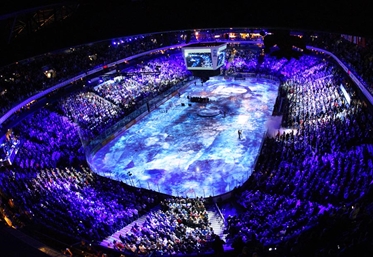Helsinki to set Euro record
Helsinki to set Euro record
68% more fans so far than in Malmo 2014

 The Hartwall Arena in Helsinki during the 2016 IIHF World Junior Championship. Photo: Andre Ringuette / HHOF-IIHF Images
The Hartwall Arena in Helsinki during the 2016 IIHF World Junior Championship. Photo: Andre Ringuette / HHOF-IIHF Images
Finnish fans remember the 2014 World Juniors well as the site of their first gold medal in 16 years. To make it even better, it was in a final game against Sweden on the archrival’s soil.
However, the Finns’ old European World Junior attendance record from 1998 in Helsinki and Hameenlinna was broken by a small margin, with 144,268 fans attending the games in the city in southern Sweden.
With the World Juniors back in Finland for the first time in 12 years, the Finnish Ice Hockey Association could claim back the record with many local and also visiting fans – notably from Canada – enjoying the games in the Finnish capital.
Four weeks before the tournament started, 120,000 tickets were already sold. Some months earlier the organizing committee’s general secretary Timo Backman told IIHF.com: “Ice hockey is a competitive sport, and our goal is to get more than 150,000 spectators.”
As of now, it looks like the Finns can set the bar even higher. After 16 games already 104,875 fans – an average of 6,554 – have visited the Hartwall Arena and Helsinki Ice Hall. That’s an astonishing 68 per cent more than Malmo had at this time two years ago when it set the new European record.
At this rate, Helsinki is likely to set a new European record on 2nd January when the quarter-finals are played. And if fans in Helsinki continue to enjoy the tournament as much in the final round, Finland could even become the first European country to surpass the 200,000 mark.
Until now only seven tournaments that happened either in Canada or close to its border (Buffalo, USA) have ever surpassed that mark since the World Juniors became an official IIHF tournament in 1977.
The competition that many hockey fans see as the most interesting international event to watch has grown immensely on both sides of the Atlantic Ocean.
Of the 12 World Juniors held in Canada, six events have surpassed the 200,000 mark –and those were the most recent six. Also, in the United States it was the last edition – the fifth overall – in Buffalo 2011 that reached the mark, and when the tournament returns in 2018, likely even more fans will attend, thanks to an outdoor game in the Buffalo Bills’ NFL football stadium.
In Europe the 1998 World Juniors became the first edition that drew an attendance of over 100,000 fans overall. They were followed by the Czechs (Pardubice & Hradec Kralove, 2002; Pardubice & Liberec, 2008), Russia (Ufa, 2013) and Sweden (Malmo, 2014).
Now Finland is set to vaporize the Swedes’ old record. If this year’s edition surpasses the 200,000 mark, the Finns would rank eighth overall. And who knows how long that would last?
The next World Juniors in Europe will be in the Czech Republic in 2020 at cities to be determined. And Czechs like records. In May they just set a new attendance record for the IIHF Ice Hockey World Championship with 741,690 fans attending 64 games in Prague and Ostrava.
Top-8 Attendance IIHF World Junior Championship in Europe (until 2015)
1. Malmo, Sweden, 2014, 144,268 total, 4,653 average
2. Helsinki & Hameenlinna, Finland, 1998, 139,680 total, 4,108 average
3. Helsinki & Hameenlinna, Finland, 2004, 116,556 total, 3,760 average
4. Pardubice & Hradec Kralove, Czech Republic, 2002, 111,128 total, 3,268 average
5. Ufa, Russia, 2013, 110,175 total, 3,554 average
6. Pardubice & Liberec, Czech Republic, 2008, 103,179 total, 3,328 average
7. Moscow & Podolsk, Russia, 2001, 84,100 total, 2,474 average
8. Leksand & Mora, Sweden, 2007, 63,493 total, 2,048 average
Top-8 Attendance IIHF World Junior Championship overall
1. Ottawa, Canada, 2009, 453,282 total, 14,622 average
2. Calgary & Edmonton, 2012, 444,718 total, 14,345 average
3. Toronto & Montreal, 2015, 336,370 total, 12,212 average
4. Buffalo & Niagara, 2011, 331,297 total, 10,687 average
5. Vancouver, Kelowna & Kamloops, Canada, 2006, 325,138 total, 10,488 average
6. Saskatoon & Regina, Canada, 2010, 301,944 total, 9,740 average
7. Halifax & Sydney, Canada, 2003, 242,173 total, 7,812 average
8. Grand Forks & Thief River Falls, USA, 2005, 193,256 total, 6,234 average
Back to Overview
















































